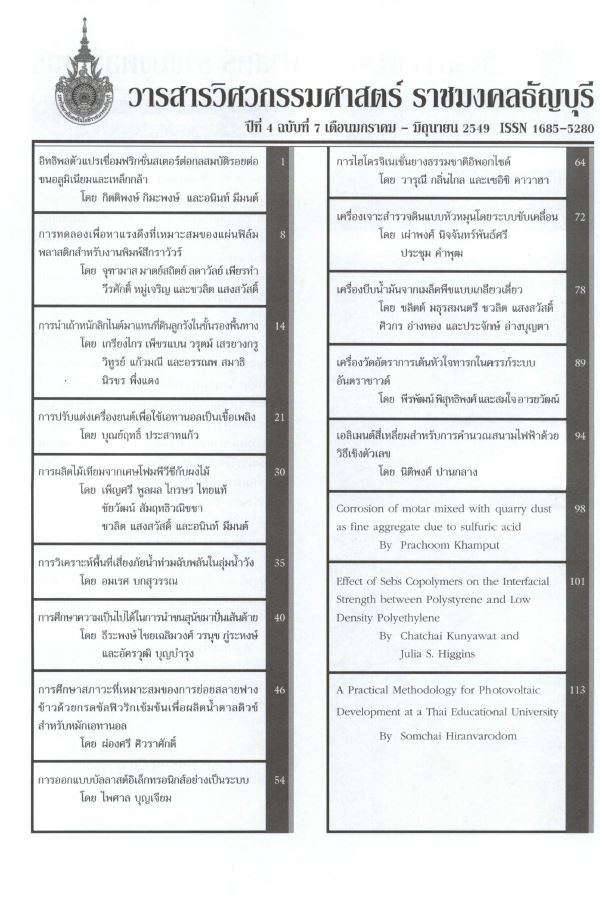Effect of SEBS Copolymers on The Interfacial Strength Between Polystyrene and Low Density Polyethylene
Main Article Content
Abstract
The relative interfacial strengths of poly (styreneblock-ethylene!butylene-block-styrene) triblock copolymers (SEBS) modified interfaces of immiscible polymers. polystyrene (PS) and low density polystyrene (LOPE). has been studied using peel test. Specimens were prepared by spin coating thin SEBS triblock copolymer films from solution onto LOPE slab. After spin coating and drying in a vacuum oven at 40 degree Celsius for several days. the LOPE slabs were placed on top of them. forming the "sandwich" arrangement. The 90 degree Celsius peel test arrangement was employed because the PS is stiff at room temperature whereas the LOPE is flexible. For thin copolymer layer (expected to leave the interface unsaturated). the trend in variation of interfacial strength with copolymer molecular weight was observed. However. for thick layers (oversaturating interface) the interfacial strength became in one case too large to separate the layers in the peel test. This may suggest a different mechanism for increasing interfacial strength when at least one of the copolymer blocks is crystallisable. Moreover. The microstructure morphology of the copolymers at the interface is expected to change during annealing time since it was found that the interfacial strength changed with annealing time.
Article Details
The manuscript, information, content, picture and so forth which were published on Frontiers in engineering innovation research has been a copyright of this journal only. There is not allow anyone or any organize to duplicate all content or some document for unethical publication.
References
Macromolecules, 22(6): 2859-2860.
Brown, H.R., Char, K., Deline, V.R. and Green, PF(1993). Effects of a diblock copolymer on adhesion between immiscible polymers. 1.
Polystyrene (PS)-PMMA copolymer between Ps and PMMA. Macromolecules, 26(16): 4155-4163.
Brown, H.R. and Yang, A.C.M. (1992). The use of peel tests to examine the self adhesion of polyimide films. Journal of Adhesion Science and Technology, 6(3): 333-346
Cho, K., Brown, H.R. and Miller, D.C. (1990). Effect of a block copolymer on the adhesion between
incompatible polymers. I. Symmetric tests.Journal of Polymer Science Part B: PolymerPhysics, 28(10): 1699-1718.
Char. K.. Brown, H.R, and Deline, V.R. (1993).Effects of a diblock copolymer on adhesion between immiscible polymers. 2. Polystyrene (PS)-PMMA copolymer between poly (phenylene oxide) (PPO) and PMMA. Macromolecules,26(16): 4164-4171.
Creton. C., Kramer, E.J, and Hadziioannou, G. (1990),Critical molecular weight for block copolymer
reinforcement of interfaces in a two-phase polymer blend. Macromolecules, 24(8):1846-1853.
Creton, C., Kramer, E.J., Hui, C.Y. and Brown, HR.(1992). Failure mechanisms of polymer interfaces reinforced with block copolymers. Macromolecules, 25(12):3075-3088.
Heck, B., Arends, P., Ganter, M., Kressler, J. and Stuhn, B. (1997). SAXS and TEM studies on poly(styrene)-block-poly(ethene-co-but-1-ene)-block-poly(styrene) in bulk and at Various interfaces. Macromolecules,30(16): 4559-4566.
Hermes, H.E. and Higgins, J.S. (1998a). Effects of processing conditions and copolymer molecular weight on the mechanical properties and morphology of compatibilized polymer blends.Polymer Engineering and Science, 38(5): 847-856.
Hermes, H.E., Buckle, D.G., Higgins, J.S. and Scherrenberg, R.L. (1998b). The Ordering of semi-crystalline PS-b-hPB copolymers at a PS/PE interface and their effects on interfacial strength. Polymer, 39(14): 3099-3108.
Kim, J, Kim, K.S, and Kim, Y.H. (1989). Mechanical effects in peel adhesion test. Journal of Adhesion Science and Technology, 3(3):175-188.
Kinloch, A.J,, Lua, C.C, and Williams, J.G. (1994).The peeling of flexible laminaates, International
Journal of Fracture, 66:45-70.
Motomatsu, M., Mizutani, W, and Tokumoto, H. (1997),Microphase domains of poly(styrene-block-
ethylene/butylene-block-styrene) triblock copolymers studied by atomic force microscopy.Polymer, 38(8): 1779-1785.
Polizu, S., Favis, B.D, and Vu-Khanh, T. (1999).Morphology-interface-property relationships in polystyrene/ethylene-propylene rubber blends. 2.Influence of areal density and interfacial saturation of diblock and triblock copolymer interfacial modifiers. Macromolecules, 32(10):3448-3456.
Russell, T.P., Anastasiadis, S.H., Menelle, A., Felcher,G.P, and Satija, S.K. (1991a). Segment density
distribution of symmetric diblock copolymers at the interface Between two homopolymers as revealed by neutron reflectivity. Macromolecules,24(7):1575-1582.
Russell, T.P., Menelle, A., Hamilton, W.A., Smith,G.S., Satija, S.K, and Majkrzak, C.F. (1991b).Width of homopolymer interfaces in the presence of symmetric diblock copolymers. Macromolecules, 24(20): 5721-5726.
Setz, S., Stricker, F,, Kressler, J., Duschek, T, and Mulhaupt, R. (1996). Morphology and mechanical properties of blends of isotactic or syndiotactic polypropylene with SEBS block copolymers.Journal of Applied Polymer Science, 59(7):1117-1128.
Tanaka, H., Hasegawa, H, and Hashimoto, T. (1991).Ordered structure in mixtures of a block copolymer and homopolymers. 1. Solubilization of low molecular weight homopolymers.Macromolecules, 24(1): 240-251,
Tanaka, K., 'Takahara, A, and Kajiyama, T, (1996),Film thickness dependence of the surfacestructure of immiscible polystyrene/poly(methylmethacrylate) blends, Macromolecules, 29(9):3232-3239,
Washiyama, J,, Creton, C., Kramer, E.J., Xiao, F, and Hui, C.Y, (1993a), Optimum toughening of
homopolymer interfaces with block copolymers.Macromolecules, 26(22):6011-6020.
Washiyama, J., Kramer, E.J,, Creton, C.F,, and Hui,C.Y. (1994). Effect of a block copolymer on the kinetics of spinodal decomposition of polymer blends. 2. Scaled structure factor.Macromolecules, 27(7): 1774-1750.
Washiyama, J., Kramer, E.J, and Hui, C.Y. (1993b).Fracture mechanisms of polymer interfaces reinforced with block copolymers: transition from chain pullout to crazing. Macromolecules, 26(11):
2928-2934.


